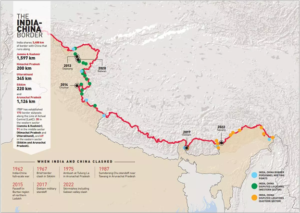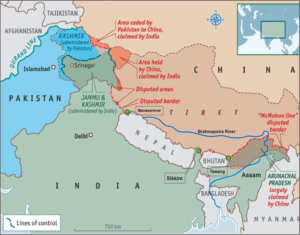India, China to hold military talks today.
Relevance:
GS Paper- 2
International Relations.
Recent News:
- India and China are set to hold the 19th round of Corps Commander talks on Monday at Chushul as part of the ongoing efforts to resolve the stand-off in eastern Ladakh, defence sources said. The talks come less than a month ahead of the G-20 Leaders’ Summit in New Delhi. Chinese President Xi Jinping is expected to attend the summit in person.
- “The Indian stance has been consistent, that is restoration of status quo ante as on April 2020, and the focus would be on disengagement from Depsang and Demchok. The above entails restoration of patrolling rights till the traditional patrolling points,” a defence source said.
- As in the earlier round, the Indian side for the talks will be led by Lt. Gen. Rashim Bali, the Leh-based 14 Corps Commander.
Previous talks:
- The 18th round of Corps Commander talks were held at the Chushul-Moldo meeting point on the Chinese side on April 23 just ahead of the Shanghai Cooperation Organisation (SCO) Defence Ministers’ Meeting.
- Since the Corps Commander-level talks began in 2020, the two sides have so far undertaken disengagement from five friction points — from Galwan after the violent clash in June 2020, from the north and south banks of Pangong Tso in February 2021, from Patrolling Point (PP) 17 in the Gogra-Hot Springs area in August 2022, and from PP15 in September 2022.
- On the Depsang Plains and Demchok, there are fundamental disagreements between the two countries. India maintains that they are the two additional friction points that still remain, while China has refused to accept it, terming them legacy issues predating the 2020 stand-off.
- On several occasions, Army chief General Manoj Pande has termed the situation along the Line of Actual Control as “stable but unpredictable”, while stating that five out of the seven friction points had been resolved and the focus was now on the remaining two points.
- Ahead of the G-20 Summit in New Delhi on September 9 and 10, Prime Minister Narendra Modi and Mr. Xi are scheduled to attend the BRICS Summit in Johannesburg from August 22 to 24. While there has been no confirmation of a bilateral meeting, there has been no denial either.
- The two leaders have not had formal bilateral talks since November 2019, when they met on the sidelines of the BRICS Summit in Brazil, but they did briefly exchange words when Mr. Modi approached Mr. Xi at a dinner during the G-20 Summit in Bali, Indonesia, in November 2022.
- While India has maintained that ties cannot go back to normal till the stand-off is resolved, with External Affairs Minister S. Jaishankar describing ties as “abnormal”, Chinese officials have sought to assert that ties were returning to the normal track and have called India to keep the border in an “appropriate” position.
- Last month, Chinese Foreign Minister Wang Yi held talks with National Security Adviser Ajit Doval in Johannesburg and with Mr. Jaishankar in Jakarta.
India-China Relationship: Evolution:
- For thousands of years, Tibet was the buffer that kept India and China geographically apart and at peace. It is only after China invaded and occupied Tibet in 1950, the two countries are sharing a common border.
- The extensive mutual historical experience was not there between the two nations and each country had a poor understanding of the psyche and system of the other.
- Before the mid-20th century, India-China relations were minimal and confined to some trade and exchange of pilgrims and scholars. Interactions began after India’s independence (1947) and the Communist revolution in China (1949).
- Nehru’s views supporting an independent Tibet gave rise to Chinese mistrust. Nehru accepted China’s suzerainty over Tibet but wanted Tibet to remain autonomous.
- Tibetan regard for India (where Buddhism originated) as their spiritual mentor and the holy land was a concern for China.
- China showed no concern for McMohan Line (1914 Simla Convention signed between the British and the Tibetan representatives) which it said was imposed by “imperialists.”
- Nehru and Zhou signed the Panchsheel treaty on 29 April 1954 to lay the roadmap for stability in a region (Hindi-Chini Bhai-Bhai) as India acknowledged Chinese rule in Tibet
- As China tightened its grip on Tibet, India gave asylum to the Dalai Lama (1959).
- In 1962, China’s People’s Liberation Army invaded India in Ladakh, and across the McMahon Line in the then North-East Frontier Agency. After the conflict, relations were in a freeze.
- Prime Minister Rajiv Gandhi’s landmark visit in 1988 began a phase of improvement in bilateral relations. India-China relations normalized through the regular exchange of high-level visits.
Areas of Cooperation:
There are several areas of cooperation between India and China-
Political Cooperation:
- Establishment of Diplomatic Relations: India became the first non-socialist bloc country to establish diplomatic relations with the People’s Republic of China in 1950.
- High-Level Visits: Exchange of visits by top leaders, such as Prime Minister Rajiv Gandhi’s visit in 1988 and Prime Minister Narendra Modi’s visits in 2014, 2015, and 2018, have contributed to improving bilateral relations.
- Dialogue Mechanisms: Both countries have established various dialogue mechanisms at different levels to discuss political, economic, consular, and regional issues.
Economic Cooperation:
- Bilateral Trade: Bilateral trade between India and China has grown significantly, reaching US$100 billion by 2022. Both countries have expanded economic ties, with India becoming one of the largest markets for “project exports” from China.
- Investments: Chinese investments in India and Indian investments in China have been increasing, particularly in sectors like IT, pharmaceuticals, and automobiles.
- Economic Potential: With a combined market of over 2.7 billion people and a GDP representing 20% of the world’s total, there is immense potential for further economic cooperation between India and China.
Science and Technology Cooperation:
- Joint Research Workshops: Both countries have organized joint research workshops to foster collaboration and innovation in the field of science and technology.
- IT Corridors: Indian companies have established IT corridors in China, promoting cooperation in information technology and high-tech sectors.
- Cultural Exchanges: India and China have a long history of cultural exchanges dating back centuries. Cultural events, performances, and agreements to establish institutions like the Yoga College in China reflect the cultural cooperation between the two countries.
Educational Cooperation:
- The education sector has witnessed cooperation, with an increasing number of Indian students studying in Chinese universities and Chinese students studying in Indian educational institutions.
People-to-People Exchanges:
Mechanisms like the China-India High-Level People-to-People and Cultural Exchanges Mechanism facilitate exchanges and cooperation in various fields, including art, media, sports, tourism, traditional medicine, and think tanks.
Defense Cooperation:
While defense cooperation remains relatively low, joint military exercises like ‘Hand in Hand’ have been conducted to enhance mutual understanding and counterterrorism capabilities.
Multilateral Cooperation:
- BRICS (Brazil, Russia, India, China, South Africa): India and China are both members of BRICS, a formal grouping of emerging economies. BRICS provides a platform for engagement between the two countries and other member states to discuss bilateral and global issues. The New Development Bank (NDB) and the Contingency Reserve Arrangement (CRA) are initiatives under BRICS that aim to provide alternative lending and financial mechanisms.
- Shanghai Cooperation Organisation (SCO): Both India and China became members of the SCO in 2017. The SCO focuses on security, geopolitics, and economic cooperation among its member states. India and China’s membership in the SCO allows for engagement and collaboration on regional and international affairs.
- Russia-India-China Trilateral (RIC): The RIC platform brings together Russia, India, and China to facilitate common positions on global challenges, discuss radical ideas, counter terrorism threats, and address issues related to Afghanistan and West Asia. It provides an opportunity for India and China to cooperate and coordinate on various global issues.
- Asian Infrastructure Investment Bank (AIIB): Both India and China are founding members of the AIIB, a multilateral development bank that aims to address infrastructure needs in Asia. The AIIB provides financing and support for infrastructure projects across the region, including in India and China.
- World Trade Organisation (WTO): India and China have collaborated within the WTO framework on various issues related to trade and agriculture. They have jointly submitted proposals, such as calling for the elimination of trade-distorting farm subsidies by developed countries, to promote fair trade practices.
- BASIC (Brazil, South Africa, India, China): The BASIC countries, including India and China, have come together to address environmental issues, particularly in the context of climate change. They have emphasized the principle of climate justice for developing countries and advocated for a more equitable approach to climate action.
Challenges:
Border Disputes:
- Western Sector: The Aksai Chin region is a territorial dispute where both countries claim it as part of their own territory.
- Middle Sector: China stakes claim over an area in Uttarakhand, creating a border dispute.
- Eastern Sector: The McMahon Line, the boundary between India and Tibet, is disputed by China.
- Johnson Line vs. McDonald Line: India and China hold different positions on the demarcation of the border.
- String of Pearls: China’s strategic presence and infrastructure development in various countries surrounding India, such as Sri Lanka, Pakistan, the Maldives, Bangladesh, and Myanmar, raise concerns about encirclement.
- Water Dispute: China’s construction of dams in the upper reaches of the Brahmaputra River (Tsangpo) without a formal water-sharing treaty poses a threat to India, leading to concerns over water availability and flooding.
- Dalai Lama and Tibet: China accuses India of fomenting trouble in Tibet due to the presence of the Dalai Lama and protests staged by Tibetans against China in India and other countries.
- Arunachal Pradesh and Stapled Visa: China issuing stapled visas to residents of Arunachal Pradesh questions India’s sovereignty and territorial integrity.
- Bhutan and Nepal: China criticizes India’s role and relationship with Bhutan and Nepal, attempting to influence their ties and play the “China card” against India.
- Belt and Road Initiative: India opposes China’s Belt and Road Initiative (BRI), particularly the China-Pakistan Economic Corridor (CPEC), which passes through Indian territory claimed by Pakistan.
- China-Pakistan Nexus: China’s support to Pakistan in military, nuclear, and missile capabilities, along with blocking India’s efforts at the UN, creates concerns for India’s security.
- Indian Ocean Region: China’s increasing presence, including military outposts, port acquisitions, and economic influence in countries like Sri Lanka, Bangladesh, and Myanmar, raises concerns for India’s traditional influence in the region.
- South China Sea: China’s territorial claims in the South China Sea, contested by neighboring countries, pose concerns for freedom of navigation and stability in the region, which affects India’s strategic interests.
- Doklam Standoff: The Doklam/Doka La region dispute between China and Bhutan, with India’s military and diplomatic support to Bhutan, has led to tensions in the area.
- Galwan Valley Standoff:The deadly clash between Indian and Chinese troops in the Galwan Valley, resulting in casualties, highlights the ongoing border tensions and the need for de-escalation efforts.
These challenges have contributed to strained relations between India and China and require diplomatic efforts and negotiations to address and resolve the disputes.
India-China Competition, Cooperation, Discord:
India-China relationship is dotted with competition, cooperation, and discord. In 2017 these played out in India’s critique of China’s Belt and Road Initiative (BRI), India’s entry into the Shanghai Cooperation Organisation (SCO), the dramatic crisis in Doklam, the acceleration of multilateral cooperation in the BRICS and attempts to foster economic engagement.
Source: https://epaper.thehindu.com/ccidist-ws/th/th_delhi/issues/47670/OPS/GENBK6KA9.1+GS9BK7D06.1.html
Question:
Due to interchanging dynamics and equations of India’s policy towards Tibet, discuss India-china relationships in the present scenario. (250 words)





